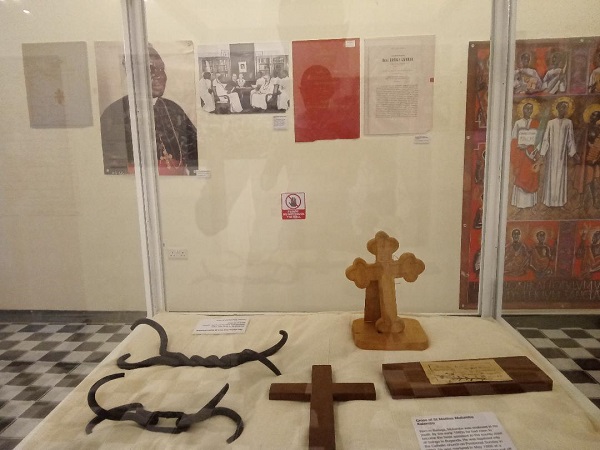
60th Anniversary of the canonization of the Uganda martyrs marked with landmark exhibition in Kampala
ART | DOMINIC MUWANGUZI | The story of the Uganda martyrs has captivated many catholics across the globe. In Uganda thousands of believers make a pilgrim to the holy shrine in Namugongo every 3rd June to commemorate their martyrdom. An exhibition to commemorate 60 years of their canonization recently opened in Kampala and features some of relics of the 22 catholic martyrs and their white fathers supervisors, artefacts from Buganda kingdom and reprduced photographs documenting the activities and life of the catholic missionaries. These physical objects are a testament to the journey of faith walked by the pages until they met their death in 1886. Equally, these relics and photographs immortalize the lives of the Martyrs in our everyday life as they’re looked on as beacon of true religious values like faith, dedication and purity. Within this context, the exhibition becomes a critical platform for believers to reflect on their spiritual life and personal relationship with their creator.
The exhibition takes on the title God and Caesar to symbolize the type of relationship the martyrs has with God who they laid their life for and Kabaka Mwanga who they served until the time of their execution. This correlation between God the supreme deity and Kabaka the heathen ruler suggest a lack of conflict between the two institutions within the context of the story of the Uganda martyrs. In spite the fact the Martyrs were put to death because of the white man’s religion, they remained loyal to the Kabaka and the monarchy by not denouncing him or their identity as Baganda, even in death. This firmly contradicts the assumption that the Martyrs were killed because they disobeyed the King and the kingdom. Conversely, their submission to suffering portrayed them as heroes in the eyes of their executioners and the Kabaka. Such bravery, exemplified their ideal duty as servants of the Kabaka to die while protecting him. However, this time it was the King of Heaven and earth who was worth to die for like they had been taught.

Noteworthy of the exhibition is its three pavilions which offer different aspects of the showcase. The first pavilion is titled Buganda in the 19th Century and gives a brief history of the Kingdom during that period. The pavilion has also the map of Buganda drawn from memory by Sr. Apollo Kaggwa and a layout structural plan of the Kabaka’s palace. Equally, it has a photograph of Kabaka Mwanga after the execution of the Uganda Martyrs with some of his chancellors. The second pavilion has the relics of the Martyrs and the White fathers. Here the viewer encounters the booth with the miniature Holy Cross of Matia Mulumba he held onto while being executed and the chains which were used to tie Joseph Mukasa Balikudembe, the first catholic martyr to be executed by Kabaka Mwanga. There’s also the cassock of Bishop Joseph Kiwanuka and a display of the type of cassock the White fathers used to wear during theie evangelism to the pages. The third pavilion has photographs and as short video of the canonization of the Martyrs in St. Peter’s Basillica Rome, Italy. The video portrays the frenzied excitement that engulfed the cathedral on 18th October 1964 as the 22 Martyrs were being officially admitted into the Roman Church as Saints. Equally, this video is a bridge between the past and present with a segment featuring living family members of the Martyrs giving testimony to the life of their respective relatives.
Beyond celebrating the 60th anniversary of the Uganda Martyrs sainthood, this exhibition clearly removes doubt about the existence of these men of faith. For many years, their story being told by different people across the globe may have sounded as fiction but this particular showcase provides enough evidence that their lives and martyrdom was real. More so, the exhibition’s ability to settle one of the most controversial photographs in the story of the Uganda martyrs underscores its credibility. For many years, a photograph showing a group of young boys with Roman Catholic missionaries at Bukumbi Mission in Mwanza, Tanganyika, was thought to be depicting the martyrs before they were executed. However, through extensive research on the true identity of the boys in the photograph, it was discovered that these were ransomed slave children who had just been freed and were now in the hands of the missionary clerics!
The works on display were secured from the Missionaries of Africa and the archives of Museum of Archeology and Anthropology, University of Cambridge. The exhibition is showing at Nkozi University, Lubaga Campus near to Lubaga Cathedral. The exhibition opens everyday of the week save for Sundays.
 The Independent Uganda: You get the Truth we Pay the Price
The Independent Uganda: You get the Truth we Pay the Price



